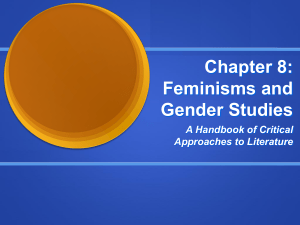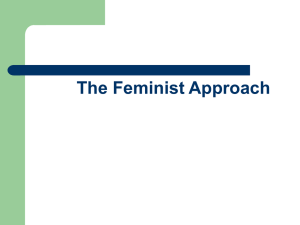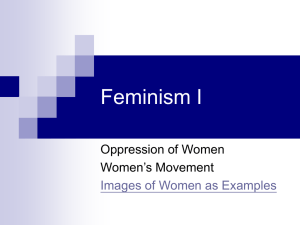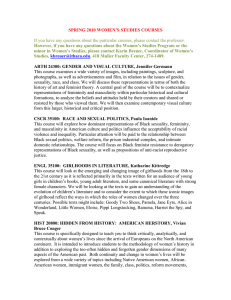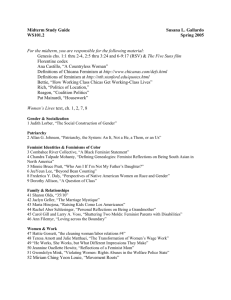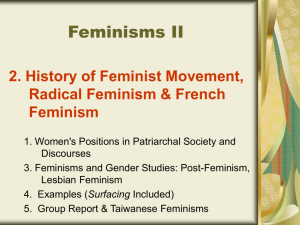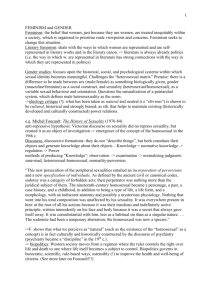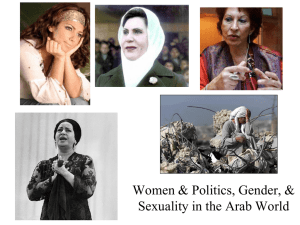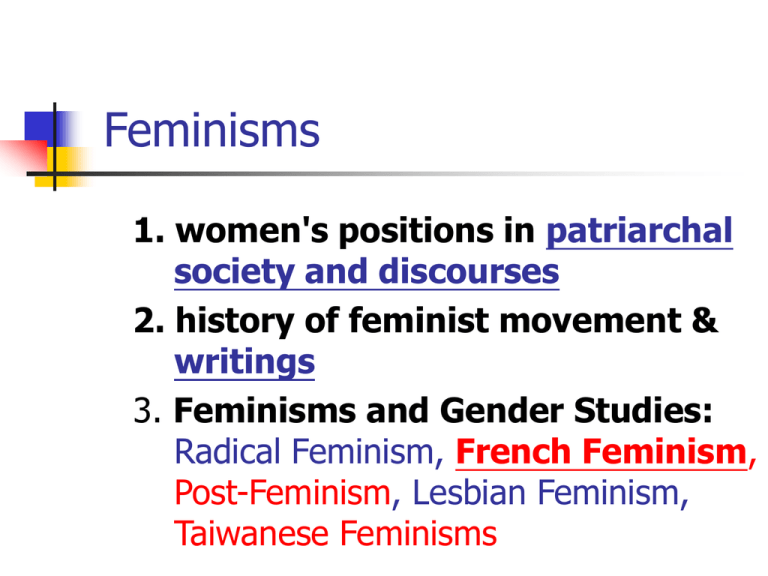
Feminisms
1. women's positions in patriarchal
society and discourses
2. history of feminist movement &
writings
3. Feminisms and Gender Studies:
Radical Feminism, French Feminism,
Post-Feminism, Lesbian Feminism,
Taiwanese Feminisms
Gender difference
1. Are men and women born different?
Or taught to be different?
2. How do women challenge patriarchy?
essential difference
reversing the hierarchy or
separation
constructed difference
challenging or blurring
the boundaries
Gender/Sex/Sexuality
sex
male
female
gender
masculine
feminine
sexuality heterosexual
homosexual
Gender/Sex/Sexuality
Gender: social construction of
“femininity” and “masculinity”
Sex: biological differences between
“female” and “male” --Does it determine
everything?
Sexuality: differences in the choice of
sexual identity, sexual partner, sexual
behavior. -- “homosexual” and
“heterosexual” –fixed by nature, by
culture, by choice, or fluid and
constructed by social environments?
Central Issues in
Contemporary Feminisms
A. 60’s -70’s -- Women’s Studies:
Women’s
本
質
1) biological: body (lesbianism;anti-pornography mov)
2) social and psychological: experience and social
position (last week)
3) linguistic: writing (last & this week)
B. 80’s – Gender Studies
1) cultural 1) gender difference & 2)
建
gender constructions (this week)
構
2) biological-psychological
Different feminist positions in the
Essentialism - Constructivism
continuum
Liberalism: equality between men and
women in the public sphere
Radical feminism: freeing women’s
bodies from patriarchal constraints and
oppression
French feminism: write from the body,
feminist writings not limited to women.
Post-Feminism: gender as a corporeal
style, an "act“ (Judith Butler)
French: Feminine ecriture
1.
Biology
feminine writing
Against the psychoanalysts’ emphasis on
Oedipus complex and the Father.
Against the fixity of male writing and systems
of thoughts (e.g. linear logic)
Cixous:
phallogocentrism
writing from the body; write in white ink; in the
Realm of the Gift vs. the Realm of the Proper
(property-- appropriate--the fear of castration)
Feminine Writing: an example
夏宇 〈在陣雨之間〉
我正孤獨通過自己行星上的曠野我正
孤獨通過自己行星上的曠野我正孤獨
通過自己行星上的曠野我正孤獨通過
自己行星上的曠野我正孤獨通過自己
行星上的曠野我正孤獨通過自己行星
上的曠野
正孤獨
我正孤獨通過
Irigaray: This Sex Which is not
one
autoeroticism; plural sexuality;
an alternate discourse that is multiple,
fluid, and heterogeneous,
feminine style: 1) mimicry; 2) "selftouching" and "self-affection" –
autoeroticism in writing
Irigaray: Mimicry + Parody e.g.
Sylvia Sleigh, The Turkish Bath, 1973
Kristeva:
the semiotic
the feminine as the silence of the
unconscious that precedes discourse;
its utterance is a flow or rhythm instead
of an ordered statement;
expression is fluid like the free-floating
sea of a womb or the milk of the breast.
E.g. Georgia O'Keeffe and Judy Chicago
Kristeva: the semiotic e.g. 1
Black Iris III,
1926
Kristeva: the semiotic e.g. 2
Cunt as Temple, Tomb,
Cave or Flower, 1974
Judy Chicago
Feminist Literary strategies
Separatism: critique of patriarchy, focus
only on women’s writings (gynocriticism),
lesbianism
Empower female characters(Granny W);
Celebrating femininity, and feminine writing
Revising tradition: e.g. fairy tales;
Open accusation; social activism, (e.g. Kruger
Mimicry; Parody; conscious use of dual
language (e.g. Cindy Sherman)
Compromise: domestication of female
desire
Issues raised by Radical
Feminists
Critiquing Patriarchy: e.g. Kate Millet,
Marilyn French (p. 175, 176)
Pornography: (pp. 193-, 199, 200)
Gender re-definition: Androgyny,
Separatism (p. 185; 186)
Gender roles: Motherhood as constraint?
Bad sex? Good sex? (p. 207)
Does our body determine our sexuality
and does our sexuality determine
everything else in our lives? (p. 218)

